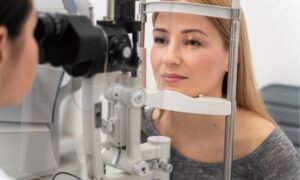Vertical heterophoria is an eye condition that affects the alignment of the eyes which leads to visual disturbances and discomfort. It involves a misalignment of the eyes which causes one eye to aim slightly higher or lower than the other. VH can lead to a variety of symptoms that can badly impact individual’s vision and overall well-being.
What is Vertical Heterophoria?
Vertical heterophoria is a type of binocular vision which is characterized by a subtle misalignment of the eyes in the vertical plane. It is often abbreviated as VH. This condition occurs due to a small difference in the positioning of the eyes which causes them to work harder to align correctly. Key points about vertical heterophoria include:
- Subtle Misalignment: VH involves a slight misalignment of the eyes, making it challenging to detect through routine eye examinations.
- Binocular Vision Disorder: It affects both eyes and disrupts the coordination between them, leading to visual discrepancies.
- Variety of Symptoms: Individuals with VH may experience a range of symptoms impacting vision and overall comfort.
Forms of Vertical Heterophoria
There are mainly two forms of vertical heterophoria:
- Monocular:
It is mainly due to visual system malfunction. It is commonly recognized as superior oblique palsy.
- Binocular:
It happens due to problem in vestibular system.
Causes and Risk Factors of Vertical Heterophoria
Main causes and risk factors of vertical heterophoria are:
- Muscular Imbalance: The condition often results from an imbalance in the extraocular muscles responsible for eye movement and alignment.
- Trauma or Injury: Head trauma or injury to the eye region may contribute to the development of VH.
- Genetic Factors: Some individuals may have a genetic predisposition to this condition.
- Age-related Changes: Aging can lead to changes in muscle tone and eye alignment, contributing to VH.
Symptoms Associated with Vertical Heterophoria
Vertical heterophoria can present a wide range of symptoms. Symptoms varies in intensity and frequency among individuals affected by the condition. Some of the main symptoms include:
- Headaches: Persistent and recurrent headaches are a common symptom of vertical heterophoria. These headaches often occur around the temples, forehead, or behind the eyes. They may worsen with visual tasks or prolonged periods of near work.
- Eyestrain and Fatigue: Individuals with vertical heterophoria frequently experience eye strain and fatigue, particularly after engaging in activities that require intense visual focus. This strain may manifest as a feeling of heaviness or tiredness in the eyes.
- Blurred or Unstable Vision: Vision may appear blurry or unstable, making it challenging to focus on objects clearly. This symptom can interfere with daily tasks, such as reading, driving, or watching television.
- Dizziness or Vertigo: Some individuals may experience sensations of dizziness or vertigo, often triggered by visual stimuli. This sensation of spinning or imbalance can be disorienting and affect one’s balance and coordination.
- Difficulty Concentrating: Vertical heterophoria may lead to difficulty concentrating on tasks, particularly those requiring sustained attention or visual focus. This symptom can impact academic performance, work productivity, and overall cognitive function.
- Double Vision (Diplopia): Double vision occurs when an individual sees two images of a single object. This symptom arises due to the misalignment of the eyes, causing each eye to perceive a slightly different image, resulting in visual overlap or duplication.
- Sensitivity to Light (Photophobia): Some individuals with vertical heterophoria may develop sensitivity to light, making them more prone to discomfort or pain when exposed to bright light sources.
- Neck and Shoulder Pain: The strain on the eye muscles due to eye misalignment can result in secondary symptoms like neck and shoulder pain. This discomfort may be attributed to the interconnectedness of muscles and nerves in the head and neck region.
- Nausea or Motion Sickness: In severe cases, individuals with vertical heterophoria may experience nausea or motion sickness, especially when visual perception and balance are affected due to eye misalignment.
Physical Findings of Vertical Heterophoria
The physical signs found on examination in patients with vertical heterophoria are:
- Subtle vertical misalignment of the eyes during the cover test.
- Variation in eye movements when looking in different directions.
- Unconscious head tilting to alleviate visual discomfort.
- Adoption of an abnormal head posture to compensate for eye misalignment.
- Detection of vertical misalignment through specialized eye tests used by professionals.
Diagnosis of Vertical Heterophoria
Vertical heterophoria is diagnosed by a comprehensive assessment conducted by an eye care specialist or an optometrist who is experienced in detecting binocular vision disorders. Main aim of the diagnostic process is to identify subtle eye misalignments. Moreover, it also evaluates associated symptoms to determine the presence and severity of vertical heterophoria. Key components of the diagnosis include:
- Symptom Evaluation: The initial step involves a detailed discussion with the patient regarding their reported symptoms. Patients are encouraged to describe their visual discomfort, headaches, dizziness, or any other related issues they may be experiencing.
- Visual Acuity Testing: A standard eye examination to assess visual clarity using an eye chart. This helps rule out refractive errors and provides a baseline for vision assessment.
- Cover Test: This diagnostic test involves covering one eye at a time while the patient focuses on an object. The eye care professional observes the movement and alignment of the eyes when uncovered to detect any misalignment, particularly in the vertical plane.
- Phoropter Test: Using a phoropter, which contains various lenses, prisms, and targets, to evaluate refractive errors and assess how the eyes function together. It allows the eye care specialist to determine the presence and magnitude of vertical heterophoria.
- Specialized Vision Testing: Advanced diagnostic tools, such as computerized vision testing equipment, may be employed to detect subtle misalignments that are challenging to identify during routine eye examinations. These tests help in quantifying the degree of eye misalignment and aid in formulating an appropriate treatment plan.
- Patient History and Clinical Evaluation: Gathering information about the patient’s medical history, any previous eye injuries or traumas, and family history of vision-related issues is crucial in understanding the potential underlying causes of vertical heterophoria.
- Collaborative Assessments: In some cases, collaboration with other healthcare professionals, such as neurologists or orthoptists, may be necessary, especially when the symptoms overlap with other conditions or when additional neurological evaluations are warranted.
Comprehensive Treatment Strategies for Vertical Heterophoria
Main aim of the treatment for vertical heterophoria is the management of eye misalignment and treatment of associated symptoms to improve visual comfort and quality of life. The choice of treatment depends on these three factors:
- Severity of the condition
- Individual symptoms
- Patient’s specific needs.
Some effective treatment modalities include:
1. Prescription Prism Lenses
Eye care professionals may prescribe glasses with specialized prism lenses. These lenses are designed to adjust the way light enters in the eyes. They help to compensate for the misalignment and assist in aligning the images seen by each eye.
2. Vision Therapy
This form of therapy comprises of series of structured exercises and activities. Vision therapy helps in improving eye coordination. It is conducted under the guidance of a trained therapist. It may include various techniques, such as:
- Occlusion Therapy: Covering one eye to strengthen the weaker eye and encourage proper alignment.
- Pursuits and Saccades: Exercises that involve tracking moving objects or rapidly shifting focus to improve eye movements and coordination.
- Stereoscopic Activities: Using specialized equipment to enhance depth perception and binocular vision.
3. Orthoptic Exercises
These exercises specifically target the extraocular muscles to enhance eye alignment and coordination.
4. Surgical Intervention
In rare and severe cases where other treatments are ineffective, surgery may be considered. Surgical correction involves adjusting the positioning of the eye muscles to improve alignment. However, this option is usually reserved for extreme cases due to its invasive nature and potential risks.
5. Multidisciplinary Approach
Collaborating with other healthcare professionals, such as neurologists, physical therapists, or occupational therapists, may be beneficial, especially when addressing associated symptoms like headaches, dizziness, or neck pain.
6. Regular Follow-ups and Adjustments
Monitoring progress and making necessary adjustments to the treatment plan are essential. Regular follow-up appointments with the eye care professional ensure that the prescribed treatment is effective and appropriately addressing the individual’s needs.
Lifestyle Modifications and Coping Strategies
Lifestyle adjustments and coping strategies are recommended in management of vertical heterophoria in order to minimize discomfort and enhance visual comfort:
- Take Breaks: Regularly rest your eyes, especially during activities that strain them, such as prolonged screen time.
- Proper Lighting: Ensure adequate lighting when reading or performing close-up tasks to reduce eye strain.
- Good Posture: Maintain proper posture to ease strain on the eyes and neck muscles.
- Follow Treatment Plan: Adhere to the prescribed treatment plan provided by your eye care professional.
FAQs
- What is vertical heterophoria?
It’s a vision disorder with slight eye misalignment causing discomfort and visual issues.
- What are the common symptoms of vertical heterophoria?
Headaches, eyestrain, blurred vision, dizziness, and difficulty focusing.
- How is vertical heterophoria diagnosed?
Through a comprehensive eye exam with specialized tests for eye alignment.
- What are the treatment options for vertical heterophoria?
Prism lenses, vision therapy, exercises, and rarely, surgery may be recommended.
- Can vertical heterophoria be cured completely?
No permanent cure, but tailored treatments greatly improve symptoms and comfort. Regular follow-ups are crucial.
For any further query about this condition feel free to contact us at https://medicalinquiries.com/contact-us/
Conclusion
Vertical heterophoria is a subtle eye condition that can significantly impact an individual’s visual comfort and overall well-being. Thorough understanding of its symptoms, causes, diagnosis and available treatment options is essential for effectively managing this condition. Seeking timely professional guidance and adhering to recommended treatments can greatly improve the quality of life for those affected by vertical heterophoria.
Disclaimer
Content on this site is written with thorough research and keeping in mind the latest guidelines. However, no content on this site should substitute professional consultation.
